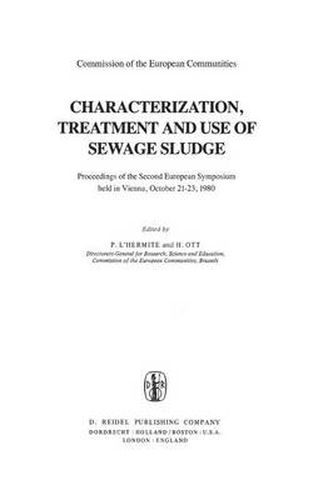Readings Newsletter
Become a Readings Member to make your shopping experience even easier.
Sign in or sign up for free!
You’re not far away from qualifying for FREE standard shipping within Australia
You’ve qualified for FREE standard shipping within Australia
The cart is loading…






This title is printed to order. This book may have been self-published. If so, we cannot guarantee the quality of the content. In the main most books will have gone through the editing process however some may not. We therefore suggest that you be aware of this before ordering this book. If in doubt check either the author or publisher’s details as we are unable to accept any returns unless they are faulty. Please contact us if you have any questions.
The object of sludge characterization must be to get quantitative mea- sures for sludge behaviour in treatment processes and when disposed of. Thus the incentive for characterization could be one of the following: 1. Because sludges exist in large quantities we want to know the amounts and the expenees involved in their treatment and disposal. 2. Because sludges are environmental nuicances/hazards, energy sourc:-es, fertilizers or even food sources; we want to know their potential. 3. Because the processes change the sludge propert~es, we w~nt to know their treatability . 4. 5ecause sludges have a history, we want to know how the generation process affects the quantities and the properties of raw sludge. Parallel to the characterization of the sludges runs characterization of the sludge treatment-processes and the environment in which we dispose of the sludge. In the following discussion we will group parameters related to sludges into three cathegories: 1. Sludge Quantity. Both total ~nd per capita sludge production data from all connnon sewage and sludge treatment methods are of interest. 2. Treatability parameters. These are characteristics of how a sludge behaves in a specific process. Typically; dewaterability and digesta- bility. 3. Sludge quality parameters. These are indicators of how the sludge could influence the environment when disposed of. Sludge quality changes through most sludge treatment processes (stabilization, ther- mal etc.) and include concentrations of chemical compounds, pathogenes etc.
$9.00 standard shipping within Australia
FREE standard shipping within Australia for orders over $100.00
Express & International shipping calculated at checkout
This title is printed to order. This book may have been self-published. If so, we cannot guarantee the quality of the content. In the main most books will have gone through the editing process however some may not. We therefore suggest that you be aware of this before ordering this book. If in doubt check either the author or publisher’s details as we are unable to accept any returns unless they are faulty. Please contact us if you have any questions.
The object of sludge characterization must be to get quantitative mea- sures for sludge behaviour in treatment processes and when disposed of. Thus the incentive for characterization could be one of the following: 1. Because sludges exist in large quantities we want to know the amounts and the expenees involved in their treatment and disposal. 2. Because sludges are environmental nuicances/hazards, energy sourc:-es, fertilizers or even food sources; we want to know their potential. 3. Because the processes change the sludge propert~es, we w~nt to know their treatability . 4. 5ecause sludges have a history, we want to know how the generation process affects the quantities and the properties of raw sludge. Parallel to the characterization of the sludges runs characterization of the sludge treatment-processes and the environment in which we dispose of the sludge. In the following discussion we will group parameters related to sludges into three cathegories: 1. Sludge Quantity. Both total ~nd per capita sludge production data from all connnon sewage and sludge treatment methods are of interest. 2. Treatability parameters. These are characteristics of how a sludge behaves in a specific process. Typically; dewaterability and digesta- bility. 3. Sludge quality parameters. These are indicators of how the sludge could influence the environment when disposed of. Sludge quality changes through most sludge treatment processes (stabilization, ther- mal etc.) and include concentrations of chemical compounds, pathogenes etc.